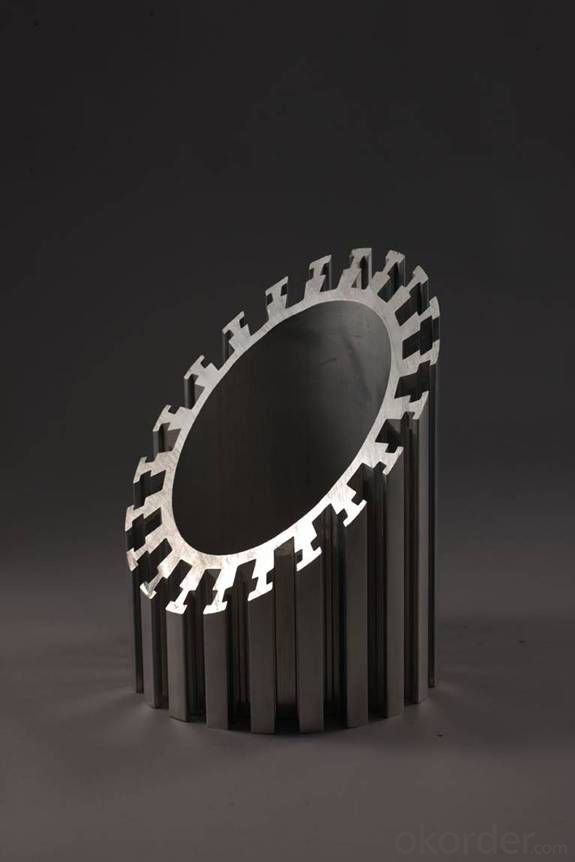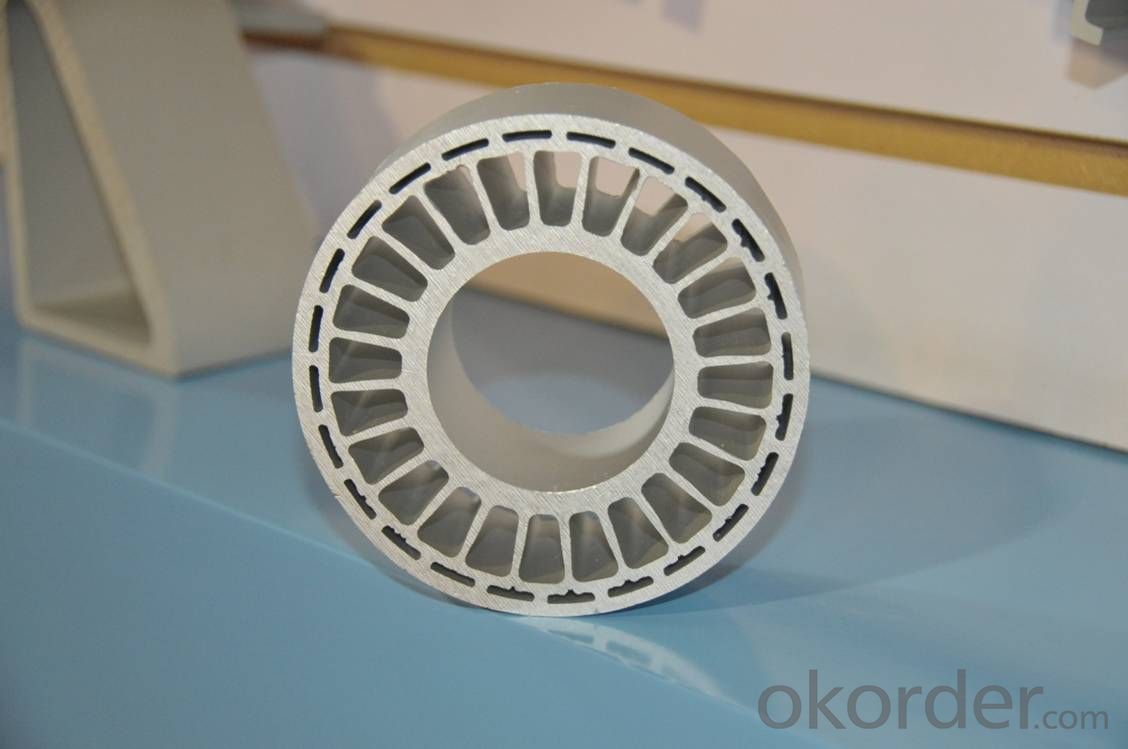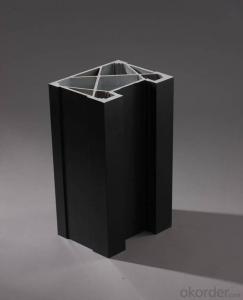Aluminium Profile for Mechanical Engineering
- Loading Port:
- Shanghai
- Payment Terms:
- TT OR LC
- Min Order Qty:
- 5 m.t.
- Supply Capability:
- 1000 m.t./month
OKorder Service Pledge
OKorder Financial Service
You Might Also Like
Item specifice
1. Structure of Aluminium Profile for Mechanical Engineering Description
Aluminium Profile for Mechanical Engineering is one semi-finished aluminium material. This coil can be rolled down to aluminium coil,sheet,circle ect. The alloy AA1050 is widly used in building, industry ect. Its weight is much lower than steel. So many customers choosed aluminium material instead of steel.
2. Specification of Aluminium Profile for Mechanical Engineering
Aluminium Profile for Mechanical Engineering | |
Main Specification | |
Alloy | AA1xxx (AA1050, AA1060, AA1070, AA1100 etc.) |
AA3xxx (AA3003, AA3004, AA3005, AA3105 etc.) | |
AA5xxx, AA6XXX (AA5052,AA5083, AA5754, AA6061, AA6062 etc.) | |
AA8xxx(AA8011, AA8006 etc.) | |
Temper | H14,H16, H18, H22, H24, H26, H32,O/F, T4, T6, T651 |
Thickmess | 0.01mm-100mm |
Width | 30mm-1700mm |
Standard | GB/T 3880-2006/ASTM |
Special specification is available on customer's requirement | |
3. Application of Aluminium Profile for Mechanical Engineering
(1).Interior: wall cladding, ceilings, bathrooms, kitchens and balconies, shutters, doors...
(2).Exterior: wall cladding, facades, roofing, canopies, tunnels,column covers , renovations...
(3).Advertisement: display platforms, signboards, fascia, shop fronts...
4. Feature of Aluminium Profile for Mechanical Engineering
Surfact Quality :
Be free from Oil Stain, Dent, Inclusion, Scratches, Stain, Oxide Dicoloration, Breaks, Corrosion, Roll Marks, Dirt Streaks and other defect which will interfere with use,
Mechenical Property:
Chemical Composite and Mechanical Property
5. Certificate of Aluminium Profile for Mechanical Engineering
SGS and ROHS(if client request, paid by client), MTC(plant provided), Certificate of Origin(FORM A, FORM E, CO), Bureau Veritas and SGS (if client request, paid by client), CIQS certificate
6. Image of Aluminium Profile for Mechanical Engineering



7. Package and shipping of Aluminium Profile for Mechanical Engineering
First, plastic cloth with drying agent inside; Second, Pearl Wool ; Third, wooden cases with dry agent , fumigation wooden pallets, aluminum surface could cover blue PVC film
8. FAQ
1) What is the delivery time?
Depends on actual order, around 20 to 35 days
2) What is the QC system:
We have QC staff of 20 persons and advanced equipment, each production is with MTC traced from Aluminum ingot lot.
3) What market do you mainly sell to?
Australia, America, Asia, Middle East, Western Europe, Africa etc
- Q:Can aluminum profiles be used in the production of agricultural equipment?
- Yes, aluminum profiles can be used in the production of agricultural equipment. Aluminum is a versatile and lightweight material that offers several advantages for agricultural applications. It is corrosion-resistant, which is essential for equipment exposed to outdoor conditions and various chemicals used in farming. Additionally, aluminum profiles can be easily shaped and customized to fit specific design requirements, allowing for the creation of complex and functional agricultural equipment. The lightweight nature of aluminum also makes it easier to transport and handle the equipment, reducing labor costs. Moreover, aluminum profiles are recyclable, making them an environmentally friendly choice for agricultural equipment production. Overall, utilizing aluminum profiles in agricultural equipment can enhance durability, efficiency, and sustainability in the farming industry.
- Q:A curtain wall predecessors?For example, under the transverse frame section, with 6m specifications, why should the material processing and minus 50mm? Insert plate, plate to cut 100mm head? What is the law?
- The column beam rod in the visual profile factory when surface treatment to hang up or put the spraying profile in oxidation tank, in sections at each end of the play of a hole, so that the hook, in the cutting process, in order to avoid the holes will be seen after the installation and so on when will the cutting part of the section cut ends, this is to cause less 50mm. As you said the core insert to reduce 100mm plate plate, this is because the length of processing of these parts is relatively small, some ten centimeters in length, the process if you use a single head saw or double saw large mechanical cutting, base metal processing machinery in a relatively short time finally can not be cut, that is to say the last 100mm~150mm machine cannot continue cutting, it is useless.
- Q:Can aluminum profiles be used for lighting fixtures or systems?
- Lighting fixtures or systems can utilize aluminum profiles. Aluminum, a lightweight and versatile material, is often chosen for constructing lighting fixtures because of its durability, resistance to corrosion, and ability to dissipate heat. Aluminum profiles can be easily shaped and sized, making them suitable for various lighting applications like recessed lighting, track lighting, pendant lighting, and more. Moreover, these profiles can be anodized or coated with different finishes to improve their visual appeal and shield them from the elements. In conclusion, incorporating aluminum profiles in lighting fixtures or systems enables efficient and effective lighting solutions while maintaining a sleek and contemporary design.
- Q:What is the terminology to explain the aluminum twist and bending and a sharp respectively.
- Twist: the section on the platform, and one end of the platform. To achieve stable profiles by self, the gap on both sides of endpoint and platform for measuring the value of the section warping end of T1 and T2, T1 and T2 is the difference between the profiles of the twist.
- Q:What are the load-bearing capacities of aluminum profiles?
- Several factors, including profile design, dimensions, material grade, and intended application, contribute to the varying load-bearing capacities of aluminum profiles. Due to their excellent strength-to-weight ratio, aluminum profiles find wide application across various industries. However, it is crucial to seek advice from the manufacturer or an engineer to obtain precise load-bearing capacity information. Typically, aluminum profiles are engineered to withstand different types of loads, namely static, dynamic, and impact loads. Static loads refer to constant weights or forces over time, while dynamic loads involve moving or changing forces. On the other hand, impact loads result from collisions or sudden changes in motion. Engineers determine the load-bearing capacity of an aluminum profile by considering its maximum allowable deflection, bending moment, shear force, and torsional stress before failure. These calculations involve the analysis of the profile's geometry, cross-sectional properties, and material properties. It is important to note that load-bearing capacities can be influenced by factors such as temperature, corrosion, surface treatment, and the presence of additional components or attachments. Therefore, it is essential to consider these factors and refer to the manufacturer's specifications or engineering guidelines for safe and reliable load-bearing capabilities. In conclusion, the load-bearing capacities of aluminum profiles are influenced by multiple factors and can vary significantly. To determine the specific load-bearing capacity for a particular aluminum profile in a given application, it is advisable to consult with manufacturers, engineers, or industry standards.
- Q:What are the advantages of using aluminum profiles in the telecommunications industry?
- There are several advantages of using aluminum profiles in the telecommunications industry. Firstly, aluminum profiles are lightweight yet strong, making them an ideal choice for constructing telecommunications infrastructure such as antenna towers and satellite dishes. Their lightweight nature allows for easy transportation and installation, reducing both time and cost. Secondly, aluminum profiles have excellent corrosion resistance properties. This is crucial in the telecommunications industry as it often involves exposure to harsh weather conditions and corrosive elements like saltwater. Aluminum profiles can withstand these conditions without deteriorating, ensuring the longevity and reliability of telecommunication equipment. Furthermore, aluminum profiles are highly adaptable and can be easily customized to meet specific design requirements. They can be extruded into various shapes and sizes, allowing for the creation of complex structures that can accommodate different telecommunications equipment. This versatility enables efficient integration of various components and facilitates the installation and maintenance processes. Additionally, aluminum profiles offer excellent thermal conductivity, which is essential in the telecommunications industry. As telecommunication equipment generates heat during operation, efficient heat dissipation is crucial to prevent overheating and equipment failure. Aluminum profiles effectively dissipate heat, ensuring optimal performance and longevity of telecommunication devices. Lastly, aluminum is a sustainable and eco-friendly material. It is 100% recyclable, meaning that old or damaged aluminum profiles can be recycled and repurposed into new products, reducing waste and environmental impact. The telecommunications industry can benefit from using aluminum profiles as part of their commitment to sustainability. In conclusion, the advantages of using aluminum profiles in the telecommunications industry include their lightweight yet strong nature, corrosion resistance, adaptability, thermal conductivity, and sustainability. These characteristics make aluminum profiles an excellent choice for constructing telecommunication infrastructure, ensuring reliable performance, and reducing environmental impact.
- Q:How do you calculate the strength of aluminum profiles?
- To calculate the strength of aluminum profiles, there are several factors that need to be considered. 1. Material properties: The first step is to know the mechanical properties of the aluminum alloy being used, such as its yield strength, ultimate tensile strength, and elastic modulus. These properties can be obtained from material data sheets or testing. 2. Cross-sectional area: The next step is to determine the cross-sectional area of the aluminum profile. This can be done by measuring the dimensions of the profile or referring to its specifications. The cross-sectional area is typically calculated by multiplying the width and height of the profile. 3. Load calculation: Once the cross-sectional area is known, the next step is to calculate the applied load on the profile. This can be determined by considering the weight or force that will be acting on the profile. The load can be static or dynamic, and it is important to account for any potential variations or impacts. 4. Stress analysis: With the load and cross-sectional area determined, the stress on the aluminum profile can be calculated using the formula: Stress = Load / Cross-sectional area. This will give the stress value in units of force per unit area (e.g., N/m2 or psi). 5. Safety factor: To ensure the profile's strength is adequate, a safety factor is typically applied. The safety factor accounts for uncertainties in the load calculations and ensures the profile can handle unexpected loads or variations. Common safety factors range from 1.5 to 4, depending on the specific application and industry standards. By considering these factors and performing the necessary calculations, it is possible to determine the strength of aluminum profiles and ensure they meet the required safety standards for their intended applications.
- Q:Can aluminum profiles be used for modular office partitions?
- Modular office partitions can indeed utilize aluminum profiles. These profiles possess characteristics such as lightness, durability, and a high strength-to-weight ratio, rendering them a perfect choice for constructing such partitions. They can be effortlessly transformed into different forms and sizes, thereby enabling customization and design flexibility. Moreover, aluminum profiles exhibit outstanding resistance against corrosion, guaranteeing prolonged performance even when exposed to high humidity conditions. Furthermore, they offer commendable thermal and sound insulation properties, thereby contributing to a pleasant and efficient office ambiance. In summary, owing to their versatility, durability, and aesthetic appeal, aluminum profiles remain a popular preference for modular office partitions.
- Q:Are aluminum profiles suitable for roofing systems?
- Yes, aluminum profiles are suitable for roofing systems. Aluminum is a lightweight and durable material that offers numerous advantages for roofing applications. It is highly resistant to corrosion, making it suitable for various weather conditions and ensuring long-term performance. Aluminum profiles also have excellent thermal properties, reflecting heat and reducing energy consumption for cooling purposes. Additionally, aluminum is easy to work with, allowing for flexibility in design and installation. Overall, aluminum profiles are a popular choice for roofing systems due to their strength, longevity, and aesthetic appeal.
- Q:Can aluminum profiles be used in swimming pool enclosures or structures?
- Yes, aluminum profiles can be used in swimming pool enclosures or structures. Aluminum is a popular choice for constructing swimming pool enclosures due to its excellent corrosion resistance and durability. It is resistant to rust and degradation from exposure to water and chlorine, making it ideal for use in a pool environment. Additionally, aluminum profiles can be easily shaped, welded, and installed, allowing for the construction of custom-designed enclosures that meet specific requirements and aesthetics. They are also lightweight, which makes them easier to handle and transport during installation. Overall, aluminum profiles offer a reliable and long-lasting solution for swimming pool enclosures or structures.
1. Manufacturer Overview |
|
|---|---|
| Location | |
| Year Established | |
| Annual Output Value | |
| Main Markets | |
| Company Certifications | |
2. Manufacturer Certificates |
|
|---|---|
| a) Certification Name | |
| Range | |
| Reference | |
| Validity Period | |
3. Manufacturer Capability |
|
|---|---|
| a)Trade Capacity | |
| Nearest Port | |
| Export Percentage | |
| No.of Employees in Trade Department | |
| Language Spoken: | |
| b)Factory Information | |
| Factory Size: | |
| No. of Production Lines | |
| Contract Manufacturing | |
| Product Price Range | |
Send your message to us
Aluminium Profile for Mechanical Engineering
- Loading Port:
- Shanghai
- Payment Terms:
- TT OR LC
- Min Order Qty:
- 5 m.t.
- Supply Capability:
- 1000 m.t./month
OKorder Service Pledge
OKorder Financial Service
Similar products
New products
Hot products
Related keywords






























